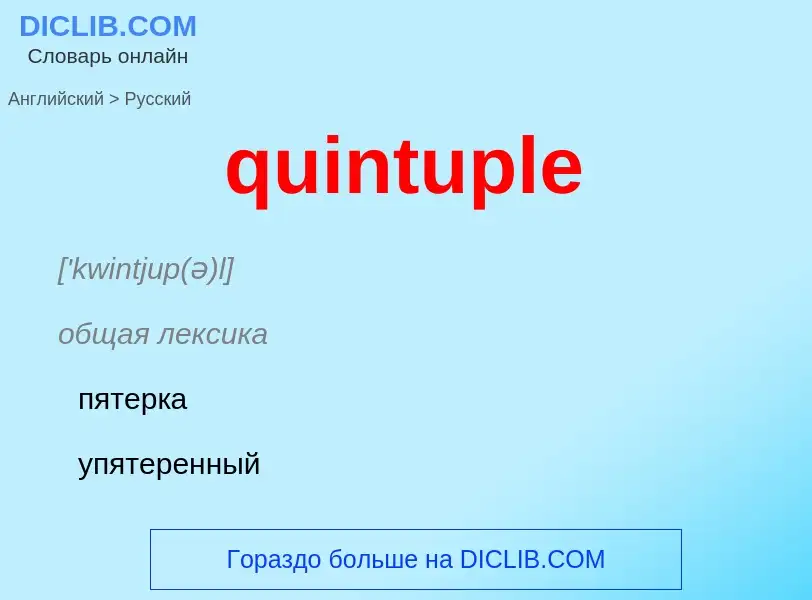Tradução e análise de palavras por inteligência artificial ChatGPT
Nesta página você pode obter uma análise detalhada de uma palavra ou frase, produzida usando a melhor tecnologia de inteligência artificial até o momento:
- como a palavra é usada
- frequência de uso
- é usado com mais frequência na fala oral ou escrita
- opções de tradução de palavras
- exemplos de uso (várias frases com tradução)
- etimologia
quintuple - tradução para russo
['kwintjup(ə)l]
общая лексика
пятерка
упятеренный
упятерять
прилагательное
['kwintjup(ə)l]
общая лексика
состоящий из пяти частей или предметов
состоящий из пяти предметов, частей
книжное выражение
пятикратный
музыка
пятидольный (о такте)
существительное
['kwintjup(ə)l]
книжное выражение
пятикратное количество (чего-л.)
редкое выражение
группа из пяти человек или предметов
морской термин
пятитрубный торпедный аппарат
глагол
общая лексика
увеличиваться в пять раз
книжное выражение
увеличивать в пять раз
Definição
Wikipédia
In mathematics, a tuple is a finite ordered list (sequence) of elements. An n-tuple is a sequence (or ordered list) of n elements, where n is a non-negative integer. There is only one 0-tuple, referred to as the empty tuple. An n-tuple is defined inductively using the construction of an ordered pair.
Mathematicians usually write tuples by listing the elements within parentheses "( )" and separated by a comma and a space; for example, (2, 7, 4, 1, 7) denotes a 5-tuple. Sometimes other symbols are used to surround the elements, such as square brackets "[ ]" or angle brackets "⟨ ⟩". Braces "{ }" are used to specify arrays in some programming languages but not in mathematical expressions, as they are the standard notation for sets. The term tuple can often occur when discussing other mathematical objects, such as vectors.
In computer science, tuples come in many forms. Most typed functional programming languages implement tuples directly as product types, tightly associated with algebraic data types, pattern matching, and destructuring assignment. Many programming languages offer an alternative to tuples, known as record types, featuring unordered elements accessed by label. A few programming languages combine ordered tuple product types and unordered record types into a single construct, as in C structs and Haskell records. Relational databases may formally identify their rows (records) as tuples.
Tuples also occur in relational algebra; when programming the semantic web with the Resource Description Framework (RDF); in linguistics; and in philosophy.

